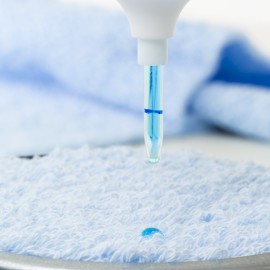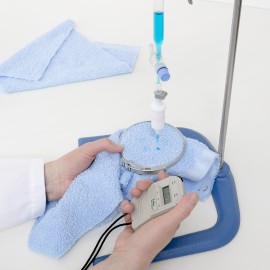Soft and gentle but still absorbent
Toweling down your skin and hair should always be a soft and gentle experience, no matter how often the towel has been washed. That's possible if it has first been treated with WETSOFT® NE 750 from WACKER, a novel hydrophilic fabric softener for industrial textile finishing.


Our grandmothers and great grandmothers already wanted soft fabrics. Underwear should obviously be pleasantly soft, since it is worn next to the skin. Towels, on the other hand, require softness for functional reasons – generally, the softer they are, the more water they should absorb.
WOVEN AND KNITTED FABRICS
Woven garments were already known in ancient Egypt. And the basic principle of weaving has hardly changed at all to this day. Weavers interlace longitudinal and transverse threads – the so-called warp and weft – to form a tight, strong fabric. However, modern looms work so fast that our eyes can no longer follow this millennia-old process. Controlled fully automatically, the weft yarn whizzes back and forth on a width of up to six meters – some 800 times per minute. In next to no time, long widths of fabric are thus created, which can later be cut to size for bed linen, shirts or towels, for example. A second large material group is knitted fabric, where a loop formed by a yarn is pulled through another loop. Due to their structure, these kinds of fabrics are more elastic than woven textiles, which is why manufacturers like to use them for underwear and sportswear.
That’s why, before the chemical industry had developed modern-day textile auxiliaries, housewives used to swap tips on how to get textiles to feel as soft as possible. For example, by hanging laundry out to dry in a place where the air is not still, but moving. A gentle breeze ensures even moisture management at the textile surface and that the fine hairs are fluffed up. Condenser dryers, as commonly found in modern households, work on the same principle. Untreated laundry – especially cotton fabrics – feels hard and stiff if dried in absolutely calm air.
Cotton is by far the most frequently used natural fiber in the manufacture of household and clothing textiles. Around a third of global textile production is based on this fiber, which is obtained from the cotton plant’s bolls and consists of over 90% cellulose. To enhance its properties, cotton is often combined with polyester-based synthetic fibers to make a so-called blended fabric.
“It is often the soft feel that ultimately makes the end customer decide on a certain product.”
Thomas Funke, Marketing Manager WACKER SILICONES
The capillary rise test is used to determine the absorbency of textiles. Here, the laboratory assistant dips test strips that were treated with silicone fluid emulsions into water that has been dyed blue. The fibers’ capillary effects suck in the water, which then travels vertically along the strip as a column. This test method, known as “wicking,” makes it possible to easily quantify the absorbency of different materials.
Regardless of whether a fabric consists of natural, synthetic or blended fibers – before it is sewn, the manufacturer dyes or prints the fabric and then “finishes” it. This technical term refers to a treatment of the fabric with surface-active substances that give it certain beneficial properties. WACKER is among the world’s leading manufacturers of products for factory textile finishing. They improve textiles or impart specific properties that are desirable for the respective product group. For example, they render woolen sweaters particularly fluffy and non-scratch, and coats or jackets water- and dirt-repellent; they ensure color fastness and, by optimal moisture management, reduce body odor. Textile auxiliaries make undershirts particularly soft and towels soft and hydrophilic – allowing them to absorb water better.
WACKER does not supply its auxiliaries directly to the textile industry, but to so-called "formulators." These manufacturers of individually adapted textile auxiliaries are familiar with their customers’ specific requirements and, in addition, are based in the same locations as the big (contract) manufacturers of the international textile industry: Pakistan, Bangladesh, China, Southeast Asia and Turkey.
The traditional bases of the European textile industry – Italy and Germany – still play their part in the international market, too. Italian weavers have specialized in particularly high-value materials, e.g. for men’s suits, while Germany is a market leader in technical textiles. These types of materials find use in car seats, airbags, reinforcement fabrics or filters, for example.

Padding on a laboratory scale: the fabric sample that is saturated with silicone is squeezed between two rollers to regulate the uptake of the active ingredient.
WACKER’s textile auxiliaries are based on silicone fluids. Since these substances are not water-soluble, formulators must emulsify them before use. There are essentially two techniques for applying the emulsion to the textiles. The fabric is either immersed in a bath containing the emulsion and pulled out again (exhausting) or the entire width of material is saturated with the emulsion and excess liquid is subsequently squeezed out between rollers (padding). For this process, there are high-performance machines that can finish 30 to 80 meters of textile width per minute, depending on the material and plant properties. Here, for every 100 grams of fabric, manufacturers apply around 0.3 to a maximum of 1 gram of auxiliary.
„WETSOFT® NE 750 combines the advantages of a macroemulsion and a microemulsion perfectly – it makes textiles soft, both on the outside and the inside, while at the same time increasing the fabric’s water absorption.”
Dr. Thomas Lehotkay, Head of Technical Marketing, Performance SiliconesThe textile market is constantly changing – and not only with regard to product design. In terms of surface treatments, demands are increasing, too. Bath towels, for example, are expected to be fluffy and soft, yet absorb a lot of moisture. We want our underwear, too, to be pleasantly soft and water-absorbent, and to dry quickly. This wouldn't be impossible without textile auxiliaries. With its WETSOFT® products, WACKER covers a wide range here. The soft feel is provided by silicone fluids that consist of long, chain-like molecules. Anchor groups are incorporated at regular intervals. They allow the chains to electrostaticly and chemically bond to the fibers. The original, entangled silicone molecule is thus strung-out; loops form at regular intervals and project out and away from the textile surface. These loops are flexible, reducing the friction between the fibers. The textile thus feels pleasantly soft and can be ironed with ease. “It is often this soft feel that ultimately makes the end customer decide on a certain product,” says Thomas Funke, marketing manager for Performance Silicones at WACKER.
Absorbent Thanks to Polyglycol
However, to finish towels, functionalized silicone fluids alone are not enough. This is because they are water-repellent, which makes them unsuitable for towels, in particular, as these are supposed to absorb water when used for drying. That’s why WACKER chemists have attached polyglycol branches to the silicone chain. Polyglycol is hydrophilic, i.e. it absorbs water. “The branches act as wicks that guide the water through the silicone loops to the textile,” reports Dr. Thomas Lehotkay, who is responsible for the technical marketing of the WETSOFT® products at WACKER SILICONES. As a result, the textile is able to rub skin and hair dry thanks to the polyglycol. At the same time, it feels soft and full due to the silicones – although not quite as snug as it would be without polyglycol, because the branches prevent the silicone loops from sliding freely.
HOW WACKER MEASURES HYDROPHILICITY
With WETSOFT® NE 750, WACKER scientists have now mastered this challenge, too. The solution lay in the development of a so-called block copolymer in which polyglycol and silicone alternate in the molecular chain. Anchor groups attach the polyglycol groups directly to the textile. In this way, the fabric can optimally absorb water. At the same time, the silicone loops are not hindered by rigid “wicks,” but can move freely. So, a WETSOFT® NE 750 finish makes textiles feel soft and cuddly and yet highly absorbent. Even re-dying the material is not a problem.
Easy to Use
WETSOFT® NE 500
Alongside the premium product WETSOFT® NE 750, WACKER also offers a ready-made, emulsified silicone-fluid product – WETSOFT® NE 500. The user only needs to dilute the concentrate by simply stirring it into cold water – this is desired by several formulators. WETSOFT® NE 500 also offers a very good and pleasant soft feel on cotton terry and knitted fabric, but a slightly lower hydrophilicity than WETSOFT® NE 750.
WETSOFT® NE 750 also offers significant advantages for the user. WACKER markets the hydrophilic fabric softener as a water-free concentrate with a high solids content. WETSOFT® NE 750 is self-emulsifying, so that formulators can easily dilute it with water to form a stable emulsion, in a ratio of approximately 1:1 to 1:4 or 1:5. Depending on customer requirements, this provides sufficient flexibility in formulating the end product. Its appearance is reminiscent of the aniseed spirit ouzo or raki diluted with water, which is also an emulsion. The droplet size lies between that of a white macroemulsion and a transparent microemulsion. WETSOFT® NE 750 combines the advantages of both in one product. It makes textiles particularly soft and, even with a longer pile, penetrates to the base of the fabric, which facilitates water absorption and considerably increases the volume that can be absorbed.
Pre-Formulated Product
By launching WETSOFT® NE 750, WACKER filled a market niche in the summer of 2015. “For the first time, there is a product for the premium segment of high-end textiles that imparts both an outstanding, pleasant soft feel and excellent absorbency,” explains Dr. Ferdinand Pradl, business team head at WACKER SILICONES. It is already pre-formulated and only needs to be diluted with water to form a stable emulsion. So, WETSOFT® NE 750 further expands the broad range of textile auxiliaries – and it certainly won’t be the last innovative product from WACKER that helps the ancient cultural asset of textiles meet 21st century demands.







